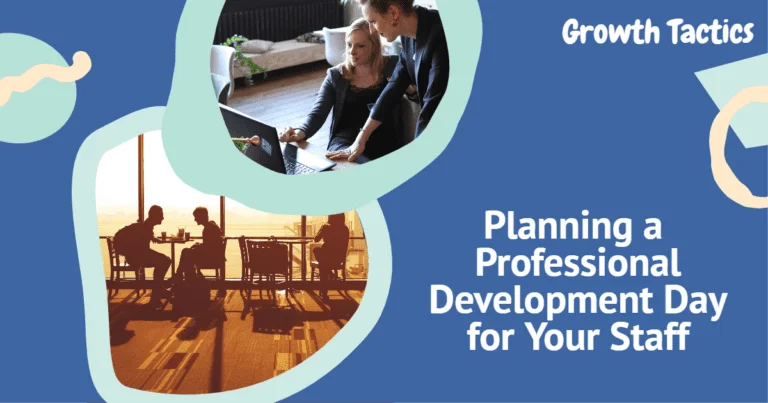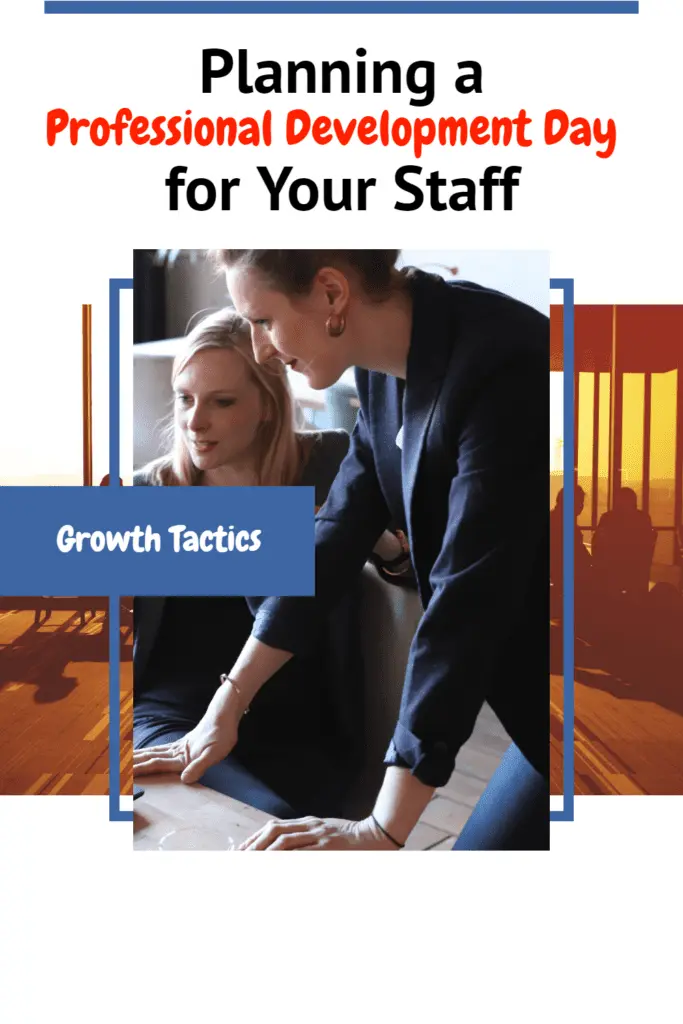Professional development days provide valuable opportunities for staff members to learn new skills, refine their expertise, and collaborate with others in their field. These dedicated days are essential in the education profession as they promote growth, engagement, and continuous improvement. In this blog post, we will explore how to plan a successful PD day for your staff, ensuring that it aligns with their needs and goals.
Jump To Section
Setting Clear Goals and Objectives
Setting clear goals and objectives is a crucial first step in planning a successful professional development day. Without clear goals, it becomes difficult to select appropriate activities, sessions, and trainings that align with the needs and aspirations of your staff members. By involving them in the goal-setting process, you promote engagement and ownership, ensuring that the day is meaningful and relevant to their professional growth.
Conducting a Survey or Holding Focus Group Sessions
To engage employees in the goal-setting process, consider conducting a survey or holding focus group sessions to gather their input and ideas. This allows staff members to contribute their thoughts and suggestions on what they would like to learn or achieve during the professional development day. By actively seeking their input, you demonstrate that their voices and professional growth are valued.
Involving Staff in the Goal-Setting Process
When involving staff in the goal-setting process, it is important to provide clear guidelines and facilitate open discussions. Encourage employees to think about their individual goals, as well as the collective goals of the organization or department. By setting goals that are aligned with both individual and organizational needs, you create a sense of purpose and motivation.
Aligning Goals with Employee Aspirations
During the goal-setting process, it is important to consider the aspirations and career goals of staff members. Ask them what skills they would like to develop, what areas they would like to improve in, and what opportunities they are seeking for professional growth. By aligning the goals of the professional development day with the aspirations of your staff, you create a sense of relevance and personal investment.
Communicating the Goals and Objectives
Once the goals and objectives have been established, it is crucial to communicate them effectively to all staff members. Clearly articulate the purpose of the professional development day, the expected outcomes, and how it aligns with the broader goals of the organization. This communication should be done in a way that is transparent, inclusive, and motivating, so that staff members understand the significance and value of their participation.
Revisiting and Reevaluating Goals
As the professional development day approaches, it is important to revisit and reevaluate the goals and objectives to ensure their continued relevance. This could involve checking in with staff members to see if their needs have changed or conducting an additional survey to gather any new ideas or suggestions. By regularly evaluating and adjusting the goals, you can ensure that the professional development day remains meaningful and impactful.
By setting clear goals and involving staff members in the goal-setting process, you lay a solid foundation for planning a professional development day that meets their needs and aspirations. This engagement and ownership will enhance their motivation and commitment to the day’s activities, maximizing the potential for growth and learning.
Creating a Diverse Training Program
To ensure that the professional development day caters to the diverse needs and interests of your staff, it is essential to create a training program that offers a variety of sessions and activities. This allows employees to choose sessions that align with their specific needs and goals, promoting their individual professional growth.
Identifying Key Areas of Focus
Before selecting sessions and activities, it is important to identify the key areas of focus for the professional development day. Consider the current trends and challenges in education, as well as the specific needs and goals of your staff members. This could include areas such as technology integration, curriculum development, social-emotional learning, and teaching strategies. By identifying these key areas, you can ensure that the training program addresses the most relevant and impactful topics.
Offering a Range of Training Sessions
Once the key areas of focus have been identified, offer a range of training sessions within each area. This allows staff members to select the sessions that are most relevant and meaningful to them. For example, within the technology integration category, you could offer sessions on utilizing educational apps, integrating online collaborative tools, or incorporating virtual reality into the classroom. By providing multiple options, staff members can tailor their professional development experience to their individual needs and interests.
Providing Different Formats and Modalities
In addition to offering a range of training sessions, consider providing different formats and modalities for learning. Some staff members may prefer traditional workshops or presentations, while others may benefit more from hands-on activities or group discussions. By offering a variety of formats, you cater to different learning styles and preferences, maximizing engagement and effectiveness.
Inviting Guest Speakers or Experts
To further enhance the diversity of the training program, consider inviting guest speakers or experts in specific areas of focus. They can offer unique perspectives, insights, and expertise that may not be readily available within your organization. Guest speakers can provide fresh ideas and valuable experiences, enriching the professional development day for staff members.
Incorporating Practical Application and Reflection
To ensure that the training program has a lasting impact on staff members’ professional practice, incorporate opportunities for practical application and reflection. This could involve providing time for staff members to apply what they have learned in their classrooms or schools, and then coming together to reflect on their experiences and share insights. By incorporating these elements, you promote the transfer of knowledge and skills into real-life contexts.
By creating a diverse training program, you empower staff members to choose sessions that align with their specific needs and goals. This tailored approach promotes engagement, relevance, and individual professional growth. Furthermore, by offering a variety of formats, inviting guest speakers, and incorporating practical application and reflection, you enhance the overall effectiveness and impact of the professional development day.
Incorporating Collaborative Opportunities
One of the benefits of professional development days is the opportunity for staff members to collaborate and learn from their colleagues. By incorporating collaborative activities into the day’s schedule, you create an environment that fosters teamwork and knowledge sharing, maximizing the potential for growth and learning.
Collaborative Projects
Encourage staff members to collaborate on projects during the professional development day. Assign groups or teams based on shared interests or goals and provide them with a specific task or problem to solve. This collaborative approach allows staff members to work together, pool their knowledge and skills, and come up with innovative solutions or ideas. Collaborative projects promote teamwork, communication, and the sharing of diverse perspectives.
Best Practice Sharing
Another way to incorporate collaboration is by providing opportunities for staff members to share best practices. Allocate time for teachers or staff members to present on successful strategies or initiatives that they have implemented in their classrooms or schools. This allows them to share their experiences and expertise, providing insights and inspiration to their colleagues. Best practice sharing promotes a culture of learning and collaboration, where staff members can learn from each other’s successes and challenges.
Group Discussions and Brainstorming Sessions
Organize group discussions or brainstorming sessions where staff members can come together to discuss topics of interest or address specific challenges. This format allows for open dialogue, idea sharing, and collective problem-solving. It encourages staff members to tap into their collective wisdom, learn from each other, and generate new strategies and approaches. Group discussions and brainstorming sessions provide a platform for staff members to collaborate and learn from each other’s experiences and perspectives.
Networking Opportunities
In addition to organized collaborative activities, provide networking opportunities for staff members. This could involve structured icebreaker activities, informal mingling sessions, or even dedicated time for staff members to meet and connect with colleagues from different departments or schools. Networking opportunities allow staff members to expand their professional networks, build relationships, and learn from others who may have different areas of expertise or experiences. By facilitating networking, you create opportunities for staff members to collaborate and learn from a wider range of perspectives.
Reflection and Feedback
After collaborative activities, provide time for staff members to reflect on their experiences and provide feedback. This can be done individually or in small groups. Reflective exercises allow staff members to process the collaboration process, identify lessons learned, and consider how they can apply what they have learned in their professional practice. Feedback can be collected through surveys or group discussions to gather insights on the effectiveness of the collaborative activities and identify areas for improvement.
By incorporating collaborative opportunities into the professional development day, you create an environment that fosters teamwork, knowledge sharing, and collective problem-solving. This collaborative approach enhances staff members’ professional relationships, promotes the sharing of best practices, and provides opportunities for learning from diverse perspectives. Ultimately, it maximizes the potential for growth and learning during the professional development day.
Providing Resources and Support
In addition to training sessions and collaborative activities, it is crucial to provide resources and ongoing support to staff members. This could include access to online learning platforms, relevant books and articles, or even mentorship programs. By offering these resources, you demonstrate your commitment to their continued growth and development.
Furthermore, ensure that there is a system in place for staff members to seek support or ask questions after the professional development day. This could be in the form of a dedicated email address or a designated time for follow-up discussions. Providing ongoing support will help them implement what they have learned and address any challenges they may encounter.
Evaluating and Gathering Feedback
To ensure the effectiveness of the professional development day, it is essential to gather feedback from staff members. This feedback will provide valuable insights into the strengths and areas for improvement of the day’s program. Additionally, it will help identify the topics and sessions that were most beneficial to staff members.
Consider distributing a survey or conducting a group discussion to gather feedback. Ask specific questions about the relevance of the sessions, the quality of the presentations, and the impact on their professional growth. Use this feedback to refine future professional development days and make them even more impactful.
Conclusion
Planning a professional development day for your staff requires careful consideration of their needs and goals. By setting clear goals, creating a diverse training program, incorporating collaborative opportunities, providing resources and support, and gathering feedback, you can ensure a successful and meaningful professional development day. These dedicated days not only promote growth and engagement but also strengthen the overall professional community within your organization. Embrace the opportunity to invest in the development of your staff and watch as they advance in their careers and contribute to the success of your organization.


